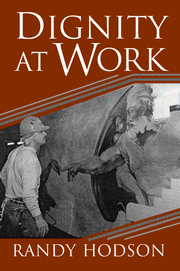Book contents
- Frontmatter
- Contents
- List of Figures and Tables
- Preface
- Part I Dignity and Its Challenges
- Part II The Practice of Dignity
- Part III The Future of Dignity
- 9 Worker Dignity and Well-Being
- 10 Dignity, Agency, and the Future of Work
- References
- Appendix A A Brief History of the Workplace Ethnography (W.E.) Project
- Appendix B Workplace Ethnography Data Set
- Appendix C Supplemental Tables
- Index
9 - Worker Dignity and Well-Being
Published online by Cambridge University Press: 28 August 2009
- Frontmatter
- Contents
- List of Figures and Tables
- Preface
- Part I Dignity and Its Challenges
- Part II The Practice of Dignity
- Part III The Future of Dignity
- 9 Worker Dignity and Well-Being
- 10 Dignity, Agency, and the Future of Work
- References
- Appendix A A Brief History of the Workplace Ethnography (W.E.) Project
- Appendix B Workplace Ethnography Data Set
- Appendix C Supplemental Tables
- Index
Summary
In prior chapters, we examined how a range of workplace challenges and opportunities influence resistance, citizenship, and relations among coworkers. These challenges and opportunities include mismanagement and abuse, assembly versus nonassembly work, professional and craft autonomy, and employee participation. In this chapter we present an integrated overview of these influences and explore their combined influence on the dignity and well-being of employees. The experiences of job satisfaction, creativity, and meaning in work will serve as touchstones for evaluating the quest for dignity in the contemporary workplace.
The integrated, multivariate models presented in this chapter suggest that the greatest impediment to dignity and to the quality of work life in contemporary organizations is management abuse and disorganization. This impediment is offset by compelling evidence that suggests that workers have a strong and abiding desire to participate meaningfully in work. This desire is manifest through widespread citizenship activities and enthusiasm for a wide range of bilateral involvements in workplace decisions.
A Synthesis
Our focus in this book is on the quest for dignity and on the creation of a world where dignity at work is possible for all. Working with dignity ultimately requires the right to participate actively in all aspects of work life, through both formal and informal means. Dignity rests on the opportunity to exercise agency – to operate purposively and effectively in one's environment. For this reason we have focused on the active behaviors of resistance, citizenship, and coworker relations.
- Type
- Chapter
- Information
- Dignity at Work , pp. 237 - 258Publisher: Cambridge University PressPrint publication year: 2001



